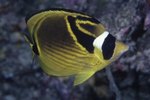Aquarium rocks do more than give a captive marine habitat a striking natural appearance; they play a crucial role in balancing the ecology of reef aquariums by hosting a variety of micro-organisms. Aquarium rocks are not inexpensive, and sourcing them can be harmful to the environment. You can make your own rocks from concrete and, with a little science, turn them into living aquarium rocks. Doing it yourself allows you to customize the rocks' sizes and shapes to suit your aquarium.
Vital Ingredients
DIY rocks are primarily made from concrete, the cured mix of cement, aggregate and water. Purchase a cement mix from your local hardware store. A limestone-based aggregate works best. You'll need sea salt, and you may also add crushed coral, coral sand, crushed sea shells, oyster grit and aragonite. These ingredients will give your rocks a natural appearance and texture, but they are not crucial to the construction of the rocks themselves, so you may choose to leave some out.
Constructing Your Rocks
Mix the cement as per the package instructions. Typically, you'll mix 3 parts aggregate to 1 part cement, then add water to achieve an oatmeal-like consistency. When your mix achieves an oatmeal-like consistency, it is ready for molding. If you're adding salt, do so now, before molding. Don’t add the salt while the cement mix is still wet, or you'll cause the cement to dissolve. To approximate the salt ratio of sea water, add 35 grams of salt to a liter of water, then place the cement in the water. Let it stand for two or three minutes, then shake off the water and place your cement on your work surface. Roll the cement in sand to get a gritty, harsh finish to approximate the appearance of natural rock. Sprinkle in a half-cup of crushed shell and coral, then mold the cement into shape with your hands. Let the size and shape of your tank guide your choice of size, keeping in consideration other tank decorations you'll employ. You don't want cement rocks to take up more than 10 percent of the aquarium's total volume.
Curing Your Rocks
Leave the cement rocks to dry on a clean, dry surface before curing. To avoid mess, lay them on newspaper or scrap wood. When they're dry, rinse excess sand, grit, coral or shell and place the rocks in a bowl of clean freshwater. Leave the rocks to soak, and regularly test the pH levels of the water with litmus paper. When the water is at a pH level of around 7.5, this indicates that the salt content is at zero. Your rocks are ready for seeding at this point.
Seeding Your Rocks
Aquarium rocks must be able to support life, otherwise they are pointless. For a healthy aquarium, bacteria and various fauna must be able to grow on the rocks. Once your rocks can support life, they become ‘living rocks.” To achieve this quickly, you need to introduce your new cement rocks into an existing ecosystem. Place them into a healthy aquarium, where they’ll attract a selection of micro-organisms, such as algae and bacteria. You don’t need to seed your rocks; you can place them straight into a new aquarium -- but it will take longer for the rocks to become live.
References
Writer Bio
Simon Foden has been a freelance writer and editor since 1999. He began his writing career after graduating with a Bachelors of Arts degree in music from Salford University. He has contributed to and written for various magazines including "K9 Magazine" and "Pet Friendly Magazine." He has also written for Dogmagazine.net.





